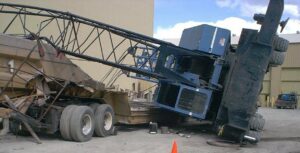By Jay Shiffler – Vice President of Business Development, WHECO World Wide Services

For agents and underwriters, the process of gathering information and performing due diligence when insuring cranes, should be detailed and thorough. Additionally, consideration must be given to how you will manage the post-accident experience should an accident occur. That means having a post-accident plan of action that includes having an established and trusted team of vendors and advisers that will assist you through the process. Unfortunately, it is often not until a crane accident occurs that you realize you may not have that team in place. Only then do you discover some not-so-pleasant truths inherent to crane accidents. In my 32 years of crane experience, including seven years of dealing specifically with post-accident insurance losses, I have discovered some hard truths about crane accidents:
– Crane accidents draw a crowd
A lot of outside parties are attracted to crane accidents, and it’s not just plaintiff attorneys. The OEMs and their dealers and agents, repair and restoration specialists, TPAs and forensics specialists—all line up looking for an opportunity to get involved. Having that established team of trusted professionals in place up-front should eliminate having to sort through the rush. Furthermore, depending on the incident, OSHA may be called in to investigate.
– Crane accidents can be, and usually are, very expensive
Cranes and crane components are expensive, and so can be the injury and collateral damage caused by crane accidents. Often times, the collateral damages outweigh the actual equipment damage. So you and your team should have mitigation and maybe subrogation high on your radar screen.
– There is a difference between processing and managing a claim
There can be a significant difference between someone with the ability to process a crane claim and someone with the ability to manage a crane claim effectively that will serve to mitigate exposure. We’ve already determined that crane accidents are expensive, so make sure that every effort is made to manage and not just process the claim.
– Most insurance adjusters don’t know cranes
There are very few claims specialists or TPAs who truly understand enough about cranes to make them effective claims managers for crane losses. However, there are some out there, so look hard and do your research. It’s especially important to have access to a qualified crane appraiser that has crane knowledge, understands values, and who can pick and fight your battles for you.
– “Experts” may not be who you think they are
Sometimes, the “experts” you hire are not the “experts” you expected, and it is made worse when you don’t know or realize it. Be sure to vet your vendors and experts to make sure they are not just paper-pushers, but truly understand how to help you manage a crane loss.
– Your accident is like chow at feeding time!
While you are trying to manage and mitigate your exposure, there are others trying to enrich and profit from it. You know that the crane accident ocean is full of sharks. Be sure to look for those fins in the water. It can sometimes be challenging to distinguish between who is trying to help you and who is just working the system. It takes everyone doing the “right thing” to fix the broken crane insurance system.
– Manufacturers are not in business to help you to manage and mitigate your post-accident exposure
Manufacturers and their distributors are in the business of selling new and used equipment, new parts, and renting equipment. They are not interested in helping you mitigate your exposure. For years the manufacturers have insisted that they have proprietary control over repairs to their accident damaged cranes. OSHA regulations allowing for third-party repairs and restoration dispel those myths, making the repair option the most viable option for accident-damaged cranes.
Read More: Crane Insurance Exposure | Working To Change the Crane Manufacturers Paradigm
– Manufacturers and their distributors can take extreme and sometimes threatening measures
Oftentimes, manufacturers and distributors try to maintain proprietary control over crane accidents, most often at great expense to the insured and insurance company. PUSH BACK! You can be compliant without the manufacturer being involved. We’re not saying not to get them involved; we’re just saying don’t let them drive the bus. If you control and manage your people, assets, and processes, then you can control the results.
– All too often, cranes are sent to salvage that were easily reparable
I personally have seen way too many repairable cranes get sent to salvage because the crane was marked as condemned by either an uneducated appraiser or a manufacturer whose decision was not in the best interest of their customer.
So, I want to encourage you that, when insuring cranes, it is important to build a team of trusted vendors and advisors, so that in the event of an accident or incident, you will have a group of allies looking after you and your insured’s best interests. WHECO is a proven partner in helping insurance companies manage and mitigate their crane and heavy equipment losses. Getting WHECO and a good adjuster involved early in the process to help you should be your first option—the repair option.




